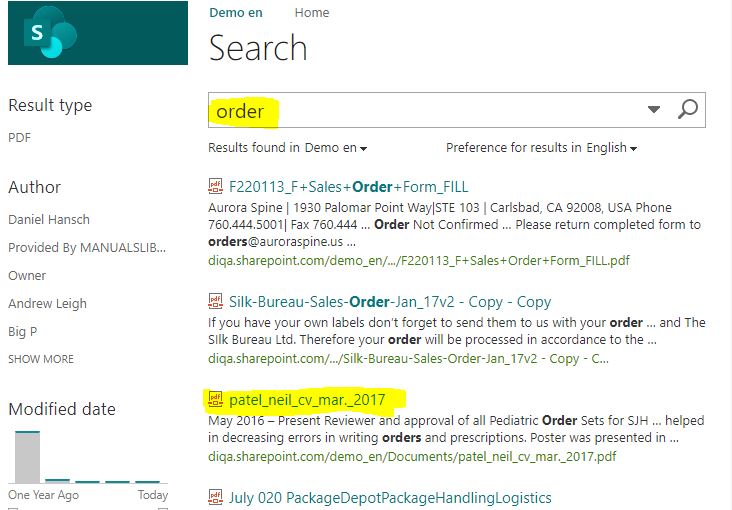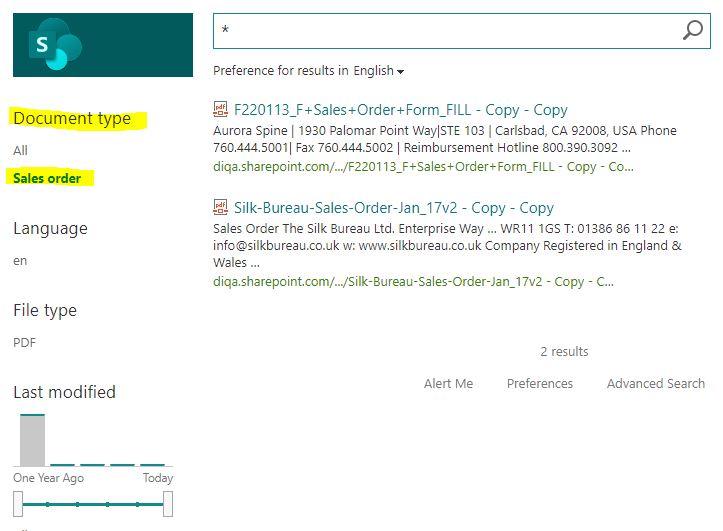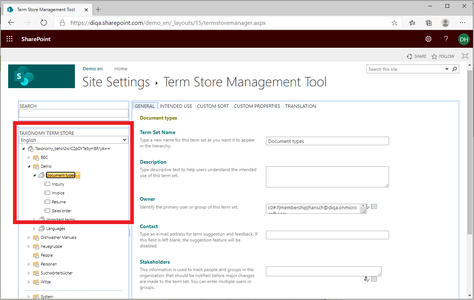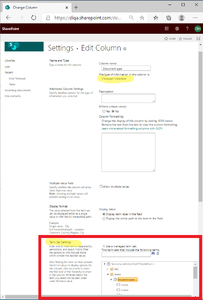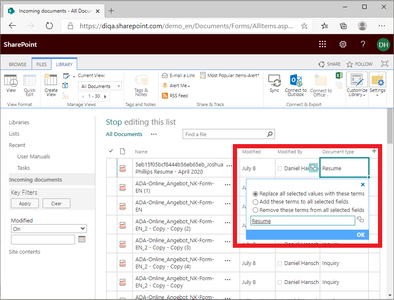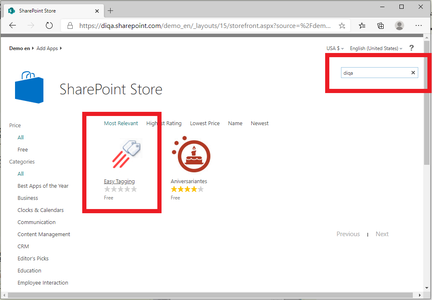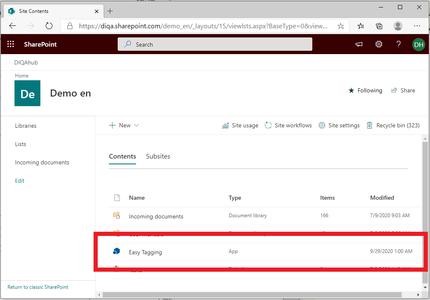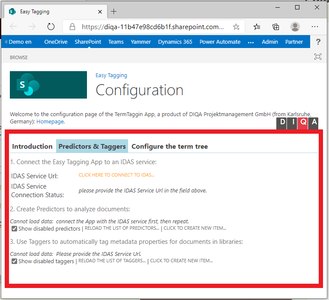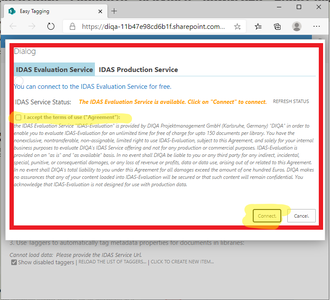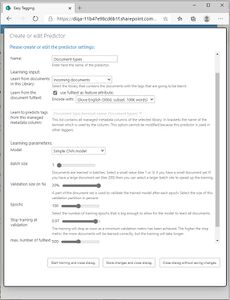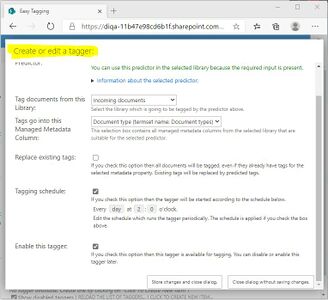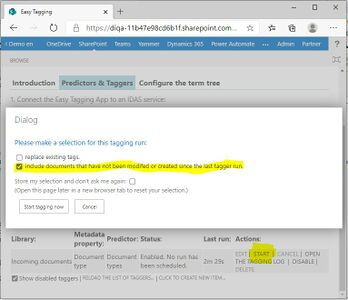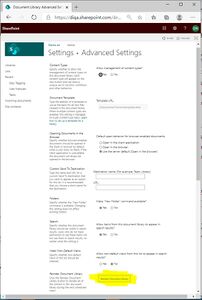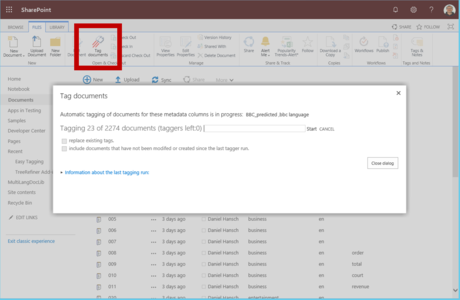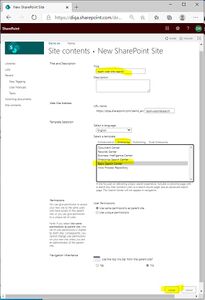Difference between revisions of "Blog/Boost document findability with tags in O365"
| Line 159: | Line 159: | ||
# Click on "Start tagging now" | # Click on "Start tagging now" | ||
# After the tagging has completed you can inspect the tagging log of the tagger (action link "open the tagging log") | # After the tagging has completed you can inspect the tagging log of the tagger (action link "open the tagging log") | ||
| − | |||
<!-- --></div> | <!-- --></div> | ||
<!-- --><div class="col-md-6 col-md-border funktionen imageExpand" style="text-align: justify; >[[File:Start_tagging_2.JPG|x300px|center|middle]]</div> | <!-- --><div class="col-md-6 col-md-border funktionen imageExpand" style="text-align: justify; >[[File:Start_tagging_2.JPG|x300px|center|middle]]</div> | ||
| + | </div> | ||
| + | <div class="row funktionen-row"> | ||
| + | <!-- --><div class="col-md-6 col-md-border funktionen" style="text-align: justify; "> | ||
| + | === 8. Important: re-index your document library === | ||
| + | # Opent the settings of your library | ||
| + | # Click on "re-index document library" | ||
| + | # Click on "Ok" to close the form | ||
| + | <big>Now all your documents in the library have been provided with tags, and the search index is being updated in the background. You can now carry on and setup the search page that uses these tags.</big> | ||
| + | <!-- --></div> | ||
| + | <!-- --><div class="col-md-6 col-md-border funktionen imageExpand" style="text-align: justify; >[[File:Library_settings.JPG|x300px|center|middle]]</div> | ||
</div> | </div> | ||
</p> | </p> | ||
| Line 174: | Line 183: | ||
<!-- --></div> | <!-- --></div> | ||
<!-- --><div class="col-md-6 col-md-border funktionen imageExpand" style="text-align: justify; >[[File:Tag_a_library.PNG|x300px|center|middle]]</div> | <!-- --><div class="col-md-6 col-md-border funktionen imageExpand" style="text-align: justify; >[[File:Tag_a_library.PNG|x300px|center|middle]]</div> | ||
| + | </div> | ||
| + | <div class="row funktionen-row"> | ||
| + | <!-- --><div class="col-md-6 col-md-border funktionen" style="text-align: justify; "> | ||
| + | === Create an Enterprise Search Center === | ||
| + | # Open the contents of your Sharepoint site and click on "subsites". | ||
| + | # Create a new sub site by clicking on the "New" action link. | ||
| + | # A form opens where you specify the new sub site. | ||
| + | # In the template field: select "Enterprise/Basic Search Center". | ||
| + | # Click on "Create" to create the new seach center. | ||
| + | <!-- --></div> | ||
| + | <!-- --><div class="col-md-6 col-md-border funktionen imageExpand" style="text-align: justify; >[[File:Create_search_center.JPG|x300px|center|middle]]</div> | ||
| + | </div> | ||
| + | <div class="row funktionen-row"> | ||
| + | <!-- --><div class="col-md-6 col-md-border funktionen" style="text-align: justify; "> | ||
| + | === Adjust the search schema === | ||
| + | # Open the contents of your Sharepoint site and click on "subsites". | ||
| + | # Create a new sub site by clicking on the "New" action link. | ||
| + | # A form opens where you specify the new sub site. | ||
| + | # In the template field: select "Enterprise/Basic Search Center". | ||
| + | # Click on "Create" to create the new seach center. | ||
| + | <!-- --></div> | ||
| + | <!-- --><div class="col-md-6 col-md-border funktionen imageExpand" style="text-align: justify; >[[File:Create_search_center.JPG|x300px|center|middle]]</div> | ||
</div> | </div> | ||
<div class="row funktionen-row"> | <div class="row funktionen-row"> | ||
Revision as of 18:02, 29 September 2020
O365: Boost document findability with tags (September 1, 2020)
Finding documents in Sharepoint online/Office 365 can be tedious. If you want to restrict your search to certain document types (like: reports, inquiries, CVs, sales orders, invoices) you either end up with too many irrelevant search hits or relevant documents don't show up because they don't include the search term. If you rely on Sharepoint's fulltext search capabilities only, then your users will be frustrated and spend too much time to find the right documents.
You can provide your users with a better search experience if you use search refiners. Users can further refine their search result by clicking on the refiner values, e.g. to retrieve "sales orders" or "invoices", only. Before you are able to create meaningful search refiners, you have to arrange for a couple of pre-requisites which include tagging documents with tags. This guide shows you how to automatically tag documents with their type (e.g. invoice, sales order, cv, inquiry) and how to provide search refiners that contain these document types.
Frustrating search experience without meaningful refiners:
Entering the search term "order" returns a lot of irrelevant documents (e.g. a CV) and even misses some sales order documents.
